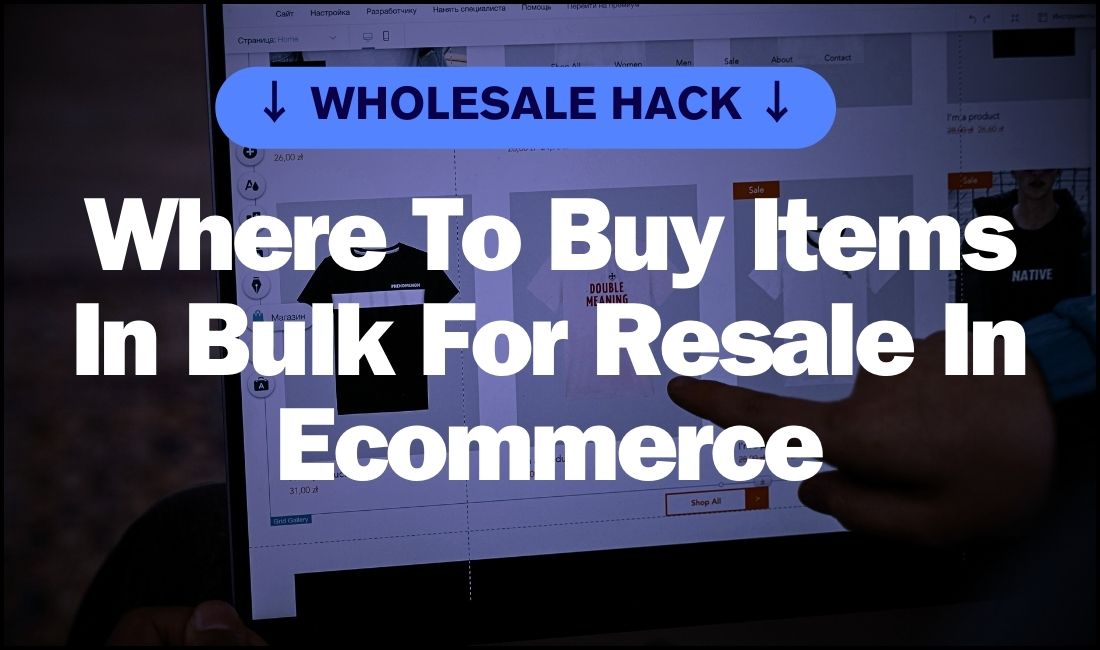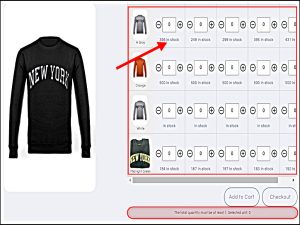
How does one enter the eCommerce marketplace? If you are someone who has an idea and wants to sell it online, then this is a question that you might have thought of. The eCommerce market can be intimidating to enter, and competition is high. One such market is where people buy in bulk and resale.
The apparel resale market is estimated to be at $250 billion in 2024, and it is expected to rise to $350 billion by 2027, according to Statista.
So, if you want to enter this market, where do you buy items in bulk for resale in eCommerce? That is the topic that I will be covering today. I will discuss where you can find your suppliers, how to approach them, what to consider, and how to enhance your eCommerce business.
Finding Your Suppliers In These 9 Places
So, where can you buy items in bulk for resale in eCommerce? There are certain places that you need to target that will give you the maximum returns. Here are the places that you need to consider:
- Trade Associations
- Local Trade Shows and Markets
- Chamber of Commerce
- Industry Trade Magazines
- Online Wholesale Marketplaces
- Local Manufacturers and Distributors
- Online Forums and Communities
- Trade Publications and Directories
- Referrals and Recommendations
Place#1 Trade Associations
Trade associations are a great place to start finding a supplier for your eCommerce business. It is a hub where an industry’s leaders and business owners gather information and connections and, of course, find reputable suppliers. Trade associations have directories of trusted wholesalers and suppliers for the specific sector it is a part of. A place like this provides a considerable wealth of information where you can start your eCommerce business and find out what you need for suppliers.
Place#2 Local Trade Shows and Markets
Trade shows, which trade associations usually host, gather industry leaders and businesses to show off new products and technology. Suppliers are one of the prominent participants in trade shows. They are there to network and find new clients like yourself. Trade shows offer invaluable face-to-face interactions to establish long-term supplier and vendor relationships.
Place#3 Chamber of Commerce
Suppose a trade association is an industry or niche-specific place where businesses gather. In that case, a chamber of commerce is where businesses get together to discuss business. These are usually local to an area, town, or city. But, they offer a great place to gather insight into the workings of a business. It is there to protect business interests on behalf of the business community. Here, you can find people working in the supply chain, and networking at your local chamber of commerce can provide just the hub to find a reliable supplier for your product.
Place#4 Industry Trade Magazines
While face-to-face interactions are great, gathering information beforehand is critical to finding the right people to talk to. That is where industry trade magazines hold that information. You can find all the latest about the industry. But more importantly, it is where wholesalers and suppliers advertise their products. You can easily find ways to contact these businesses to possibly run your very own eCommerce wholesale business.
Place#5 Online Wholesale Marketplaces
The internet is where suppliers are abundant. You are probably a simple Google search away from finding the ideal wholesale marketplace where suppliers gather to sell their products. You can browse extensive product catalogs, compare pricing and terms, and conveniently manage multiple supplier relationships. Sites like Alibaba, Worldwide Brands, and Thomasnet are significant online marketplaces where you can gather suppliers to resale in your eCommerce store.
Place#6 Local Manufacturers and Distributors
Those online wholesale markets would require extensive shipping costs to get the product to you. So, instead of going online, you can look through your local manufacturers and distributors. That is a perfect place to start finding distributors for what you want to sell. If you live in an area that is famous for making certain products, that is even more lucrative. Logistics and monitoring can be done more efficiently when manufacturing is done locally.
Place#7 Online Forums and Communities
Online forums and communities are valuable knowledge-sharing platforms. On there, you can seek advice, exchange experiences, and receive recommendations from other business owners for reputable suppliers. By participating in these communities, you can gain insights into hidden gems and emerging trends in the supplier landscape, all from the comfort of your office.
Place#8 Trade Publications and Directories
Trade directories are invaluable for new startups and those in the eCommerce business. It is where suppliers and wholesalers have their names for business owners to find. Trade publications and directories compile extensive lists of wholesalers and manufacturers, offering a comprehensive resource for your eCommerce businesses. These directories will have all the necessary information for contacting the suppliers, and you can set up a meeting with them to see if they are right for you.
Place#9 Referrals and Recommendations
Finding and vetting the right supplier for your business can be stressful. That is where referrals and recommendations from trusted sources offer a shortcut to finding reliable suppliers. Trustful entrepreneurs, mentors, and industry professionals can help you identify reputable wholesalers with proven quality and reliability track records. It takes away half the work if you can find the right person to get trustworthy recommendations from.
Approaching The Supplier To Purchase In Bulk And Resell In 5 Easy Steps
So now you have a list of suppliers you either talked to at trade shows or found through your research that you want to approach. The question is: how do you approach a supplier to purchase in bulk? Don’t worry because I will share how you will be doing that in these easy steps:
Step#1 Narrowing Down Your List
Your list will be extensive, and contacting each will waste time. So, the first thing to do is narrow down your list. Recommendations should go first, followed by suppliers you have directly talked to at trade shows, etc. This is just one way. You can also rely on online reviews and the niche products you want to buy and resale in eCommerce. Make sound judgments and go for suppliers most likely to do business with you.
Step#2 Initiating First Contact With Suppliers
Once you have the narrowed list, the next step is to contact the suppliers. But how do you initiate the first contact with suppliers? Sending an email or calling the suppliers directly are great initial ways to contact your suppliers.
When you are contacting them, keep in mind these questions that you can ask so that you can get the ball rolling to acquire them as your suppliers:
- Minimum quantity order for purchase
- Payment terms and return policies
- Shipping costs and lead times
- Total costs and volume discount possibilities
- Quality control and scalability
- Access to references and referrals
- Sample availability
You can reach the next step when you have secured all the necessary answers.
Step#3 Asking For Samples
Samples are tester products before you buy the final product from suppliers. The sample will give you an idea of your final product and how you can improve it to match your specifications. If you like the samples, you can move on to the next step of acquiring a supplier.
I want to mention about asking for samples from international suppliers. International wholesalers and suppliers might have problems sending in samples due to high shipping costs. You could ask for a minimum order to test it out but note that this might be costly.
Step#4 Purchasing From The Supplier
After approving the samples, it is time to purchase the products from the suppliers. Here is where you finalize all the terms and conditions with your suppliers. Whether you agreed on volume discounts, how the products will be shopped, and at what time should be finalized here. This is essentially the final step in acquiring the supplier in this guide, but it could be the start of your eCommerce business’s most essential business relationship.
Step#5 Adding Items On Your eCommerce Store
You will need a platform to sell the products as an eCommerce business. Shopify is a great eCommerce platform on which to start selling your products. So for this step, I will use a Shopify store as an example.
Once you set up your Shopify store, you must add the products you acquired from your suppliers. To add the products to your Shopify store, this is what you have to do:
- Log in to Shopify: Use your credentials to access your Shopify account.
- Access Products: Navigate to your Shopify dashboard’s “Products” section.
- Click “Add product”: Find the button to add a new listing.
- Enter Details: Fill in essential information such as product title, description, images, pricing, and available inventory.
- Add Images: Upload high-quality images that showcase your product effectively.
- Set Price and Inventory: Specify the price for your product and the quantity available in your inventory.
- Organize (Optional): If you’ve created collections, categorize your product accordingly to make it easier for customers to find.
- Save and Publish: Review your product details and click the “Save” button to add it to your store. If everything looks good, publish the product so it’s visible to customers.
With that all out of the way, you are ready to sell your product on your eCommerce store.
Increasing Your Resale Value With Greater Customer Satisfaction With A Bulk Order App On Shopify
So you have done everything so far. You have bought the products you want to sell and even set up your Shopify store to start selling. However, you might encounter problems with satisfied customers shopping at your Shopify store.
Shopify store owners have access to the Shopify app store to help make the shopping experience much better for customers. Here is an example of a Shopify store using a bulk order mix-and-match bundle app to increase customer satisfaction on their store:

The store uses this app to showcase all the variants available for one product. It could be size and color, then showcased in a grid view. Here the customers can choose how much of a product they want and see how many are left in stock. A restriction is also placed so customers do not accidentally add the products to the cart.
Such an app allows customers to select all the variants they want and, with one click, add all of them to the cart. This will enable customers to shop for every variant they wish on one product page without switching tabs to individually add all the variants they want to the cart. It streamlines the shopping experience, increasing customer satisfaction when interacting with the store.
The inventory stock badge also allows the shop to show how many products are left so that customers know they will receive the product without worrying about it going out of stock. This is done for all individual variants, which is great for customers to understand. Finally, the restriction allows customers to add the right amount of variants to the cart. It reduces errors while shopping, which customers will appreciate.
All of this is possible from one app on the Shopify app store. These types of apps can transform your Shopify store and streamline your store’s shopping experience to ensure more confirmed orders and make it easier for customers to finalize their purchasing decisions.
Bottom Line
The wholesale hack is knowing where to buy items in bulk for resale in eCommerce. You can find the right supplier in many different places, and approaching them can be intimidating. However, for a successful eCommerce store, it is the first of many steps you need to take. With the right attitude (and hacks!), your online store is on the road to success.
